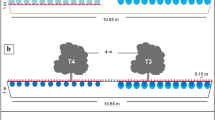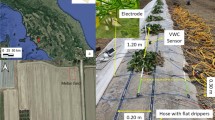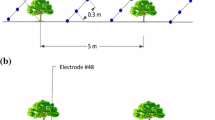Abstract
In many orchards, irrigation scheduling is designed based on data from meteorological networks and considering homogeneous soil properties. Such assumptions may result in inefficient irrigation, which is difficult to constrain without expensive or invasive techniques. Here we have evaluated the ability of the electrical resistivity tomography (ERT) for detecting meter-scale irrigation uniformity and deep percolation during irrigation. The spatiotemporal variability of soil volumetric water content (VWC) in a vineyard located near Santiago (Chile) was inferred using ERT monitoring of two irrigation cycles. The electrical resistivity structure up to 4 m depth was estimated using two-dimensional inversion of ERT data. ERT results were verified by comparing resistivity models with VWC measured with soil moisture sensors, soil properties mapped in a 2 m-depth soil pit, and the spatiotemporal evolution of VWC obtained by solving numerically Richards equation. Largest temporal variations of resistivity were observed within the root depth (1 m) and are consistent with expected relative changes in VWC during irrigation. ERT images exhibit lateral changes in resistivity at these depths, likely indicating non-uniform infiltration of water controlled by observed soil texture variations. Resistivity changes were also observed below the root zone, suggesting that a fraction of the irrigation water percolates downward. These findings can be explained by an excess of irrigation water applied during the monitoring, which was planned considering regional evapotranspiration (ET) data that overestimated the actual ET measured at the vineyard. Altogether, our results suggest that ERT monitoring during irrigation is a cost-effective tool to constrain the performance of irrigation systems.









Similar content being viewed by others
Availability of data and materials
Requests for data and materials should be addressed to Jaime Araya Vargas.
References
Alamry AS, van der Meijde M, Noomen M, Addink EA, van Benthem R, de Jong SM (2017) Spatial and temporal monitoring of soil moisture using surface electrical resistivity tomography in Mediterranean soils. CATENA 157:388–396
Allred B, Daniels JJ, Ehsani MR (2008) Handbook of agricultural geophysics. CRC Press, Boca Raton
André F, van Leeuwen C, Saussez S, Van Durmen R, Bogaert P, Moghadas D, de Rességuier L, Delvaux B, Vereecken H, Lambot S (2012) High-resolution imaging of a vineyard in south of France using ground-penetrating radar, electromagnetic induction and electrical resistivity tomography. J Appl Geophys 78:113–122
Boaga J, Rossi M, Cassiani G (2013) Monitoring soil-plant interactions in an apple orchard using 3-D electrical resistivity tomography. Procedia Environ Sci 19:394–402. https://doi.org/10.1016/j.proenv.2013.06.045
Bouyoucos GJ (1962) Hydrometer method improved for making particle size analysis of soils. Agron J 54:464–465
Brillante L, Bois B, Mathieu O, Bichet V, Michot D, Lévêque J (2014) Monitoring soil volume wetness in heterogeneous soils by electrical resistivity. A field-based pedotransfer function. J Hydrol 516:56–66
Brower C, Prins K, Heilbloem M (1989) Irrigation water management: irrigation scheduling, training manual no. 4. FAO, Rome
Brunet P, Clément R, Bouvier C (2010) Monitoring soil water content and deficit using Electrical Resistivity Tomography (ERT)–a case study in the Cevennes area, France. J Hydrol 380(1–2):146–153
Calamita G, Brocca L, Perrone A, Piscitelli S, Lapenna V, Melone F, Moramarco T (2012) Electrical resistivity and TDR methods for soil moisture estimation in central Italy test-sites. J Hydrol 454:101–112
Cassiani G, Boaga J, Vanella D, Perri MT, Consoli S (2015) Monitoring and modelling of soil–plant interactions: the joint use of ERT, sap flow and eddy covariance data to characterize the volume of an orange tree root zone. Hydrol Earth Syst Sci 19(5):2213–2225. https://doi.org/10.5194/hess-19-2213-2015
Cassiani G, Boaga J, Rossi M, Putti M, Fadda G, Majone B, Bellin A (2016) Soil–plant interaction monitoring: small scale example of an apple orchard in Trentino, North-eastern Italy. Sci Total Environ 543:851–861. https://doi.org/10.1016/j.scitotenv.2015.03.113
Constable SC, Parker RL, Constable CG (1987) Occam’s inversion: a practical algorithm for generating smooth models from electromagnetic sounding data. Geophysics 52(3):289–300
Cunningham RL, Matelski RP (1968) Bulk density measurements on certain soils high in coarse fragments. Soil Sci Soc Am Proc 32:109–111
Dai A (2013) Increasing drought under global warming in observations and models. Nat Clim Change 3(1):52–58. https://doi.org/10.1038/nclimate1633
DGA (2012). Estrategia Nacional de Recursos Hídricos 2012-2025. Ministerio de Obras Públicas. https://www.mop.cl/Documents/ENRH_2013_OK.pdf. Accessed Dec 2019
Evett SR, Parkin GW (2005) Advances in soil water content sensing: the continuing maturation of technology and theory. Vadose Zone J 4:986–991
Friedman SP (2005) Soil properties influencing apparent electrical conductivity: a review. Comput Electron Agric 46(1–3):45–70
Garré S, Javaux M, Vanderborght J, Pagès L, Vereecken H (2011) Three-dimensional electrical resistivity tomography to monitor root zone water dynamics. Vadose Zone J 10(1):412–424
Garreaud RD, Alvarez-Garreton C, Barichivich J, Boisier JP, Christie D, Galleguillos M, LeQuesne C, McPhee J, Zambrano-Bigiarini M (2017) The 2010–2015 megadrought in central Chile: impacts on regional hydroclimate and vegetation. Hydrol Earth Syst Sci 21(12):6307–6327. https://doi.org/10.5194/hess-21-6307-2017
Garreaud RD, Boisier JP, Rondanelli R, Montecinos A, Sepúlveda HH, Veloso-Aguila D (2019) The central Chile mega drought (2010–2018): a climate dynamics perspective. Int J Climatol. https://doi.org/10.1002/joc.6219
Greaves RJ, Lesmes DP, Lee JM, Toksöz MN (1996) Velocity variations and water content estimated from multi-offset, ground-penetrating radar. Geophysics 61(3):683–695
Hagrey SA, Müller C (2000) GPR study of pore water content and salinity in sand. Geophys Prospect 48:63–86. https://doi.org/10.1046/j.1365-2478.2000.00180.x
Hardie M, Ridges J, Swarts N, Close D (2018) Drip irrigation wetting patterns and nitrate distribution: Comparison between electrical resistivity (ERI), dye tracer, and 2D soil–water modelling approaches. Irrig Sci 2018(36):97–110
Hubbard S, Grote K, Rubin Y (2002) Mapping the volumetric soil water content of a California vineyard using high-frequency GPR ground wave data. Lead Edge 21(6):552–559. https://doi.org/10.1190/1.1490641
Huisman JA, Hubbard SS, Redman JD, Annan AP (2003) Measuring soil water content with ground penetrating radar. Vadose Zone J 2(4):476–491
Israelsen OW (1950) Irrigation principles and practices, vol 471. Wiley, New York
Keller GV, Frischknecht FC (1966) Electrical methods in geophysical prospecting. Pergamon Press, Oxford, p 517p
Kljun N, Rotach MW, Calanca P (2004) A simple parameterisation for flux footprint predictions. Bound Lay Meteorol 112:503–523
Kljun N, Calanca P, Rotach MW, Schmid HP (2015) A simple two-dimensional parameterisation for Flux Footprint Prediction (FFP). Geosci Model Dev 8:3695–3713. https://doi.org/10.5194/gmd-8-3695-2015
Klotzsche A, Jonard F, Looms MC, van der Kruk J, Huisman JA (2018) Measuring soil water content with ground penetrating radar: a decade of progress. Vadose Zone J 17(1):1–9
Kowalski AS, Anthoni PM, Vong RJ et al (1997) Deployment and evaluation of a system for ground-based measurement of cloud liquid water turbulent fluxes. J Atmos Ocean Tech 14:468–479. https://doi.org/10.1175/1520-0426(1997)014%3c0468:DAEOAS%3e2.0.CO;2
Lowrie W (2007) Fundamentals of geophysics. Cambridge University Press, Cambridge
Marchant M, Cecioni A, Figueroa S, González H, Giglio S, Hebbeln D, Kaiser J, Lamy F, Mohtadi M, Pineda V, Romero O (2007) Marine geology, oceanography and climate. In: Moreno T, Gibbons W (eds) The geology of Chile. Geological Society of London, London. https://doi.org/10.1144/GOCH.11
Mary B, Peruzzo L, Boaga J, Schmutz M, Wu Y, Hubbard SS, Cassiani G (2018) Small-scale characterization of vine plant root water uptake via 3-D electrical resistivity tomography and mise-à-la-masse method. Hydrol Earth Syst Sci 22:5427–5444. https://doi.org/10.5194/hess-22-5427-2018
Mary B, Vanella D, Consoli S, Cassiani G (2019) Assessing the extent of citrus trees root apparatus under deficit irrigation via multi-method geo-electrical imaging. Sci Rep 9:9913. https://doi.org/10.1038/s41598-019-46107-w
Meza FJ, Vicuña S, Jelinek M, Bustos E, Bonelli S (2014) Assessing water demands and coverage sensitivity to climate change in the urban and rural sectors in Central Chile. J Water Clim Change 5(2):192–203
Michot D, Benderitter Y, Dorigny A, Nicoullaud B, King D, Tabbagh A (2003) Spatial and temporal monitoring of soil water content with an irrigated corn crop cover using surface electrical resistivity tomography. Water Resour Res 39(5):1138. https://doi.org/10.1029/2002WR001581
Moreno Z, Arnon-Zur A, Furman A (2015) Hydro-geophysical monitoring of orchard root zone dynamics in semi-arid region. Irrig Sci 33(4):303–318. https://doi.org/10.1007/s00271-015-0467-3
Morlat R, Jacquet A (1993) The soil effects on the grapevine root system in several vineyards of the Loire valley (France). Vitis 32:35–42
Oldenborger GA, Routh PS, Knoll MD (2005) Sensitivity of electrical resistivity tomography data to electrode position errors. Geophys J Int 163(1):1–9
Reverter BR, Sánchez-Cañete EP, Resco V et al (2010) Analyzing the major drivers of NEE in a Mediterranean alpine shrubland. Biogeosciences 7:2601–2611. https://doi.org/10.5194/bg-7-2601-2010
Reynolds SG (1970) The gravimetric method of soil moisture determination, Part I. A study of equipment, and methodological problems. J Hydrol 11:258–273
Richards LA (1931) Capillary conduction of liquids through porous mediums. Physics 1:318–333
Robinson DA, Campbell CS, Hopmans JW, Hornbuckle BK, Jones SB, Knight R, Ogden F, Selker J, Wendroth O (2008) soil moisture measurement for ecological and hydrological watershed-scale observatories: a review. Vadose Zone J 7:358–389
Samouëlian A, Cousin I, Tabbagh A, Bruand A, Richard G (2005) Electrical resistivity survey in soil science: a review. Soil Tillage Res 83(2):173–193
Sandmeier, K.J. (2019) ReflexW Version 9. Program for processing of seismic, acoustic or electromagnetic reflection, refraction and transmission data. Software Manual, Karlsruhe, Germany
Schaap MG (2002) Rosetta: a computer program for estimating soil hydraulic parameters with hierarchical pedo-transfer functions (Version 1.2). http://cals.arizona.edu/research/rosetta/rosetta.html
USDA (US Department of Agriculture) (1977) National soil survey handbook, title 430-VI. Part 618.87 Texture Triangle and Particle-Size Limits of AASHTO. USDA and Unified Classification Systems, Washington DC
Valdés-Pineda R, Pizarro R, García-Chevesich P, Valdés JB, Olivares C, Vera M, Balocchi F, Pérez F, Vallejos C, Fuentes R, Abarza A, Helwig B (2014) Water governance in Chile: availability, management and climate change. J Hydrol 519(PC):2538–2567
Van Genuchten MT (1980) A closed-form equation for predicting the hydraulic conductivity of unsaturated soils 1. Soil Sci Soc Am J 44(5):892–898
Vanella D, Cassiani G, Busato L, Boaga J, Barbagallo S, Binley A, Consoli S (2018) Use of small scale electrical resistivity tomography to identify soil-root interactions during deficit irrigation. J Hydrol 556:310–324. https://doi.org/10.1016/j.jhydrol.2017.11.025
Waxman MH, Smits LJM (1968) Electrical conductivities in oil-bearing shaly sands. Soc Petrol Eng J 8(02):107–122
Webb EK, Pearman GI, Leuning R (1980) Correction of flux measurements for density effects due to heat and water vapour transfer. Q J R Meteorol Soc 106:85–100
Zhou B, Dahlin T (2003) Properties and effects of measurement errors on 2D resistivity imaging surveying. Near Surf Geophys 1(3):105–117
Zond Geophysical Software (2016). ZondRes2D. Program for two-dimensional interpretation of data obtained by resistivity and induced polarization methods (land, borehole and marine variants). Saint-Petersburg, 2010–2016
Acknowledgements
This work was funded by FONDECYT Grant 1170429 and partially supported by FONDECYT Grant 1181392. We gratefully acknowledge Pedro Ruiz-Tagle (vineyard landowner) and Pedro Mesina (vineyard manager) for allowing us to conduct this study and their logistical support. We thank Fernanda Gallegos, Sergio Gutiérrez, Matías Lillo, Catalina Lizarde, María Cecilia Muñoz, Francisco Suárez and Damián Tosoni for helping during geophysical measurements. We wish to thank the two anonymous reviewers and the editor for their comments, which significantly contributed to improve the original version of this paper. We thank Zond Software© for the demo version of Zondres2d available at http://zond-geo.com/english/. Jaime Araya Vargas was financially supported by FONDECYT Postdoctoral Grant 3180182. Data can be requested by contacting Jaime Araya Vargas (jaarayav@ing.puc.cl).
Funding
Fondo Nacional de Ciencia y Tecnología (FONDECYT) Grant 1170429.
Author information
Authors and Affiliations
Corresponding author
Ethics declarations
Conflict of interest
On behalf of all authors, the corresponding author states that there is no conflict of interest
Additional information
Publisher's Note
Springer Nature remains neutral with regard to jurisdictional claims in published maps and institutional affiliations.
Appendix: ERT data fit
Appendix: ERT data fit
Tables 4 and 5 show the misfit between observations and preferred inversion models’ responses for all ERT surveys made with N = 4 and N = 1, respectively. Initial RMS error is the average misfit between observations and the response of the starting model (a 70 Ωm homogenous half space). The data misfit range indicates the differences between measured data and model responses observed overall quadripoles, expressed as percentage of the measured data value (Figs. 10, 11, 12).
Comparison between observations and preferred model responses for ERT surveys made with N = 4. For each day, upper panel shows the pseudosection calculated from observed data, middle panel shows the pseudosection calculated from the inversion resistivity model, and lower panel shows the inversion resistivity model. Black dots in pseudosections indicate the estimated location of apparent resistivity points measured with each quadripole
Comparison between observations and preferred model responses for ERT surveys made with N = 1. For each day, upper panel shows the pseudosection calculated from observed data, middle panel shows the pseudosection calculated from the inversion resistivity model, and lower panel shows the inversion resistivity model. Black dots in pseudosections indicate the estimated location of apparent resistivity points measured with each quadripole
Sensitivity test of resistivity feature C2 for ERT surveys made with N = 4. Comparison between observations and responses of a modified version of the preferred model, where a 100 Ωm rectangle replaces the area roughly occupied by C2 in the preferred model. For each day, upper panel shows the pseudosection calculated from observed data, middle panel shows the pseudosection calculated from the inversion resistivity model, and lower panel shows the inversion resistivity model. Dashed-line polygons in pseudsections panels outline the areas where the datafit is worse than in the preferred model responses. Dotted-line polygons in model panels outline the 100 Ωm rectangle that was added to the preferred model. Global RMS error for each model is indicated
Rights and permissions
About this article
Cite this article
Araya Vargas, J., Gil, P.M., Meza, F.J. et al. Soil electrical resistivity monitoring as a practical tool for evaluating irrigation systems efficiency at the orchard scale: a case study in a vineyard in Central Chile. Irrig Sci 39, 123–143 (2021). https://doi.org/10.1007/s00271-020-00708-w
Received:
Accepted:
Published:
Issue Date:
DOI: https://doi.org/10.1007/s00271-020-00708-w







